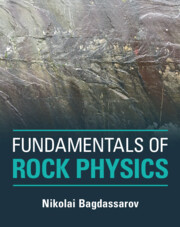Book contents
- Fundamentals of Rock Physics
- Fundamentals of Rock Physics
- Copyright page
- Dedication
- Contents
- Preface
- 1 Introduction
- 2 Density and Porosity
- 3 Stresses in Rocks
- 4 Mechanical Strain and Elastic Moduli
- 5 Permeability of Rocks
- 6 Mechanical Properties of Fluid-Bearing Rocks
- 7 Acoustic Properties of Rocks
- 8 Electric Resistivity
- 9 Dielectric Properties
- 10 Magnetic Properties of Rocks
- 11 Thermal Properties of Rocks and Minerals
- 12 Radioactive Properties of Rocks
- Index
- References
12 - Radioactive Properties of Rocks
Published online by Cambridge University Press: 19 November 2021
- Fundamentals of Rock Physics
- Fundamentals of Rock Physics
- Copyright page
- Dedication
- Contents
- Preface
- 1 Introduction
- 2 Density and Porosity
- 3 Stresses in Rocks
- 4 Mechanical Strain and Elastic Moduli
- 5 Permeability of Rocks
- 6 Mechanical Properties of Fluid-Bearing Rocks
- 7 Acoustic Properties of Rocks
- 8 Electric Resistivity
- 9 Dielectric Properties
- 10 Magnetic Properties of Rocks
- 11 Thermal Properties of Rocks and Minerals
- 12 Radioactive Properties of Rocks
- Index
- References
Summary
There are geogenic and cosmogenic contributions to the radioactivity of rocks. Radioactivity arises from the relationship between the atomic mass number, the number of protons and neutrons, and the atomic ordinal number in a radioactive element. Radioactive nuclei decay according to the exponential law. There are three natural decay series: uranium-radium, uranium-actinium, and thorium. The 87Sr/86Sr ratio in rocks and seawater is used for paleo-tectonic reconstructions. The measurement of gamma spectra is an important component of radiometry. Measurement of natural radioactivity using a gamma-spectrometer is considered. Fossil tracks of α-particles in rocks and minerals may be used to measure the time since the rock sample formed. Muon energetic spectra are used to estimate underground cavities. Radioactive emanations are connected with the gas radon, and their efficiency depends on rock porosity, saturation and mineral grain size. There are several methods for dating rocks using radioactive and stable isotope ratios: 87Sr/86Sr, ∝87Rb/86Sr and K-Ar. The Oklo reactor is a unique natural nuclear reactor. Focus Box 12.1: Binding energy Eb. Focus Box 12.2: Excitation and loss energy.
Keywords
- Type
- Chapter
- Information
- Fundamentals of Rock Physics , pp. 505 - 540Publisher: Cambridge University PressPrint publication year: 2021
References
Literature
- 1
- Cited by



